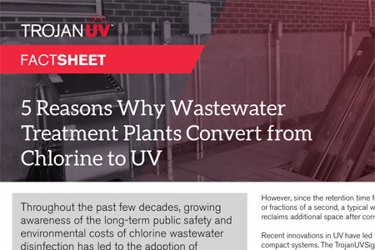5 Reasons Why Wastewater Treatment Plants Convert From Chlorine To UV Treatment

Throughout the past few decades, growing awareness of the long-term public safety and environmental costs of chlorine wastewater disinfection has led to the adoption of inherently safer alternatives, such as UV. In fact, the first UV wastewater disinfection system in the U.S. was installed back in 1982 and now roughly 50% of the wastewater in North America is treated with UV. This includes new plants as well as existing ones that have converted from chlorine.
UV is the most effective, safe and environmentally friendly way to disinfect wastewater. Unlike chemical approaches to water disinfection, UV light provides rapid, effective inactivation of microorganisms through a physical process. When bacteria, viruses and protozoa are exposed to germicidal wavelengths of UV light, they are rendered incapable of reproducing and infecting. The process adds nothing to the water but UV light, and therefore, has no impact on the chemical composition or dissolved oxygen content of the water.
There are many reasons why plants make the switch from chlorine to UV – here are five of them.
Get unlimited access to:
Enter your credentials below to log in. Not yet a member of Water Online? Subscribe today.
